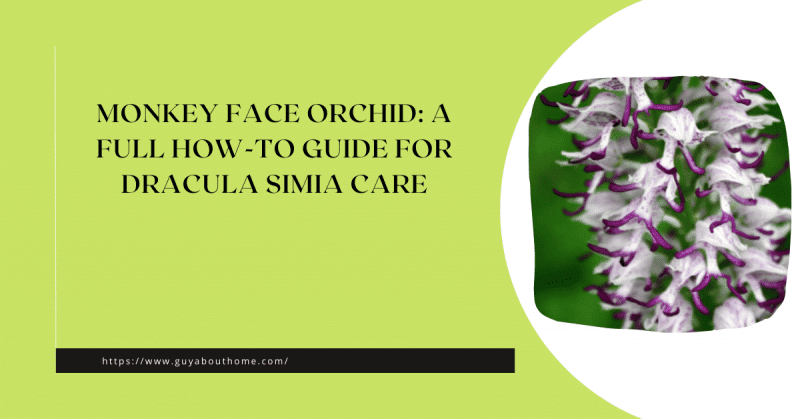Are you planning to grow a Monkey Face orchid in your home and are wondering how to take care of it? Here’s a full monkey orchid care guide for you!
Monkey Face orchids grow in very specific environmental conditions. So if you want them to survive, you really need to take good care of them. But no worries.
Thank you for reading this post, don't forget to the best blogger Guy About Home who offers the best garden and home improvement tips! If you are a home decor and design fan, don't miss the tips on home ideas. If you are a home garden owner, then you might be interest in our complete guides to house plants!
Are monkey faced orchids real?
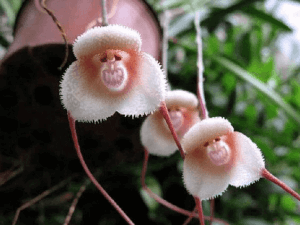
Source: Pinterest
The plant was called the Monkey Face orchid because of its resemblance to the simians.
The blossoms of Monkey Face orchids can come in different colors including green, brown, yellow, orange, white, pink, red, blue, purple, and black. Similar to majesty palm, they have three petals that have long spines originating from the center of the blossoms. They can also have multiple colors in the form of stripes, dots, or patterns that form a monkey’s face. They usually have two dark eyes, dotted and fuzzy eyebrows, a furry nose, and a beard similar to the one you see on simians.
The main compositions of Monkey Face orchids include the following:
- A rhizome with nodes producing shoots and roots
- Dense stem clusters coming from the rhizome
- Long, linear, green, fleshy leaves growing from each stem
- Single triangular blossoms
Monkey Face Orchid Facts & Overviews
Latin Name: Dracula Simia,Epipremnum ‘Manjula’
English Name: Monkey Face Orchid
In fact, its scientific name roughly translates to “little dragon monkey”. It is best paired with lush plants like rubber trees, pineapple plants, and dwarf banana trees.
Other monkey face orchids facts
- Its original habitat is in the steep mountains of Peru and Ecuador
- It grows at high altitudes (3,000 feet or more)
- It can bloom in any season
- Its blossoms smell like ripe oranges (this makes it a great center of attraction in any garden)
Other Orchids That Look Like Monkeys
how many different species of orchids are there?
Monkey Face orchid has more than 110 varieties and more than half of the Dracula genus can be spotted in Ecuador. There are several orchid species that share the term “Monkey Face orchid” and below are the most popular ones:
#1 Dracula Amaliae
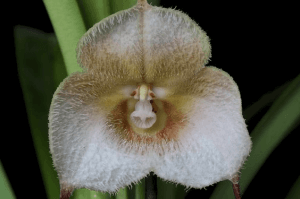
Source: Pinterest
- Also called Amalia’s Dracula
- Found in Columbia’s cloud forests
- Small to medium size
- Blooms can be pale yellow, cream, or brown
- It blooms in the winter to spring
- 10-cm wide flowers that are usually flat
#2 Dracula Hawleyi
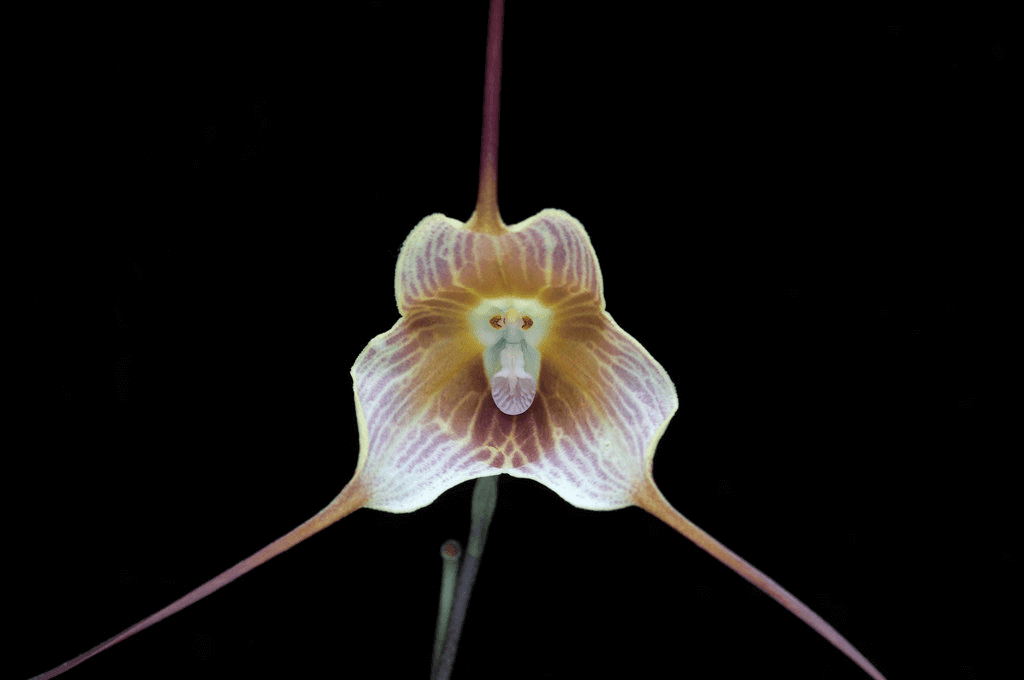
Source: Flickr
- Also called Hawley’s Dracula
- It blooms in the fall
- Single 3-cm wide flower
- Small and shallow lip
#3 Dracula Gigas
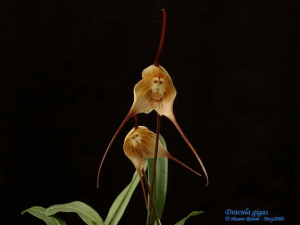
Source: Pinterest
- Also called the gigantic Dracula
- It blooms from spring to fall
- Single 10-cm wide flowers
- It looks like Dracula Hawleyi but has a darker color and pink lip
#4 Orchis Simia
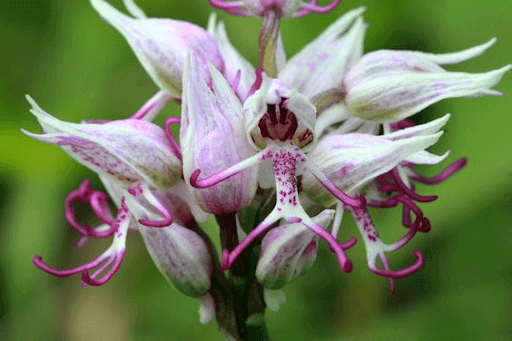
Source: Pinterest
- Grows from 15 to 30 cm tall
- It has four to six pale green leaves
- Reddish to greyish pink species
- It has a lobed lip that mimics the shape of a monkey’s body
#5 Dracula Benedictii

Source: Pinterest
- Small orchid
- Long, thin leaves
- Dark maroon flowers with light yellow interiors and long tails
#6 Dracula Wallisii
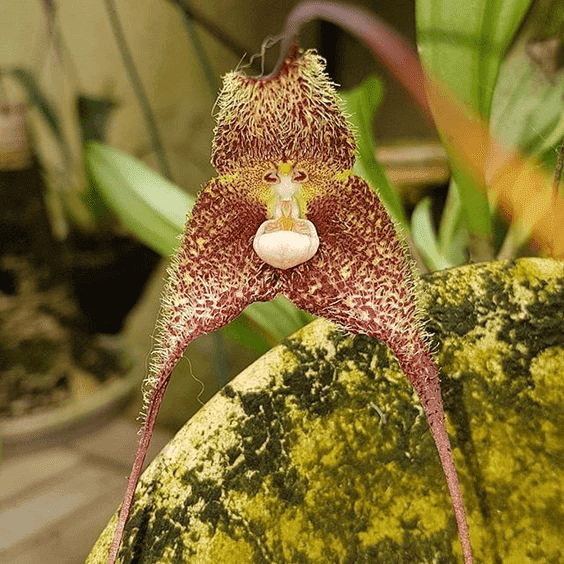
Source: Pinterest
- Light yellow flowers with maroon speckles
- Blooms have large light-colored lips that make the flowers look like big-chinned monkeys
Monkey Face Orchid Care: Things to Know
Besides this plant, we also make a full care guide on how to care for Monstera siltepecana.
Are monkey face orchids rare?
The Monkey Face Orchid is a very rare species that only grows at high elevations in cool and dim environments. Like manjula pothos, they are not edible but pollinators in the wild such as moths, ants, and bees love their blossoms.
where do monkey face orchids grow?
Monkey Face orchid is an epiphytic rhizome plant that grows in subtropical climates and tropical highland forests
Are monkey face orchids an indoor plant?
It is popularly used as an indoor and ornamental plant as well as in floristry. Although it is an interesting plant that you can add to your home garden, taking care of it is quite challenging.
Are monkey face orchids hard to grow?
This is why it is not recommended for those who are just starting to grow their first houseplant.
Monkey Face orchids are commonly used as ornamental plants but they are not usually found in homes because they are hard to grow.
Is monkey face orchid toxic?
As for toxicity, monkey Face orchid are non-toxic to both animals and humans.
how tall and big does monkey orchids can grow?
Monkey Face orchid can grow from 12 to 20 inches in height. Its small blooms can expand to around two inches. They can even reach up to 11 inches when their spikes are included. As for the growth phase, they emerge from underground rhizomes. They grow multiple stalks, each producing one flower.
How long do monkey orchids live?
Monkey Face orchid can take up to two months before the leaves will sprout and three to eight years before they start flowering. After the first flowers, the orchid will consistently produce flowers for up to 20 years before it dies.
Monkey Face Orchid Care Requirements
Lastly, let us give you tips on how to grow a Dracula Simia orchid. Dracula Simia plants require specific living conditions, so you need to give them regular care. Evaluate the plant is worth of growing. If not, you can try the other types of plants, ficus triangularis, polyscias fabian, trachyandra tortilis, crispy wave fern, monkey face orchid, manjula pothos, lemon button fern are also good options since they are easy to care for.
#1monkey face orchid planting Environment
Outdoors
- Areas that belong to the USDA plant hardiness zones ranging from 9 to 11
- Warm subtropical climates
- 40-45°F nighttime temperature and an average of 68°F day time temperature
- A humidity of around 80%
Indoors
- Greenhouse residence to meet the plant’s humidity requirements
- With the orchid’s high humidity requirements, you need to ensure proper air circulation to prevent root rot
#2 monkey face orchid Soil
- Use soils that are specific for orchids because they can hold moisture better while still being able to drain rapidly. They can also provide adequate airflow and circulation.
- It should replicate the orchid’s original environment
- Maintain a soil pH of 5.5 to 7 (you can use a cheap pH test strip to accurately assess the soil’s acidity)
If you cannot acquire a soil mix from a store, you can create your own orchid solid with this recipe:
- Four parts Fir bark (medium)
- One part perlite, coconut husk chips, or sphagnum moss
- One part charcoal (medium)
You might also want to add some loose material such as stones to the pot’s bottom before putting the soil mix to improve drainage.
#3 monkey face orchid Potting
- Make sure that the roots of the orchid will have enough room to spread in the pot
- The pot should have drainage holes to get rid of excess water and prevent root rot
#4monkey face orchid lighting
- Monkey Face orchids despise bright light and will suffer when exposed to too much indirect light
- Cool dim environments
- Place your plant in shady conditions (just like their natural habitat in the forest) but not in a dark place
- The plant’s leaves should feel cool when touched. If the leaves are warm, your orchid might have been exposed to too much sunlight.
#5 monkey face orchid watering
- Monkey Face orchids do not have pseudobulbs that are used to store water. Thus, they will need a lot of water that they can use during drought periods.
- Always water in the morning
- Water your plant once a week
- Mist regularly to replicate the orchid’s humid and moist environment
- Decrease your watering frequency when you notice signs of fungal issues or root rot
- Make sure that the excess water escapes through the pot’s drainage holes when watering
- If you put the pot on a plant saucer, make sure to empty the saucer so your plant won’t absorb the accumulated water back
- Although Monkey Face orchids can survive when under-watered, don’t let them dry out
When to Water
There are two ways you can determine if it’s time to water your Monkey orchid:
-
By Sight
If the roots are silver or white-hued, it’s time to water. If they are mottled or green, skip watering.
-
By Feel
If the soil feels slightly damp when touched, it needs watering.
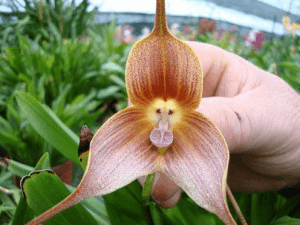
Source: Pinterest
#6 monkey face orchid humidity
- High humidity and moist conditions
- Collapsing blossoms is a sign of the lack of humidity in the environment
- You can increase the humidity through the following:
- Putting your plant in a greenhouse
- Daily misting (don’t mist that the blossoms directly)
- Put the pot above a shallow tray of water
- Use a humidifier
Take note that high humidity leads to the formation of molds. To prevent this from happening, increase air circulation by using a fan.
#7 monkey face orchid Temperature
- Cool temperatures because the natural habitat of Monkey Orchids are in Ecuador’s high mountains
- They can handle up to 70°F but grow best in temperatures ranging from 50 to 60°F
- Keep your orchids away from cold and hot drafts (do not place them near cooling or heating vents)
#8 monkey face orchid Fertilizing
- The best fertilizer to use would a 20-20-20 ratio of NPK (nitrogen, phosphorus, potassium)
- You can also use:
- Nitrate nitrogen or ammoniacal nitrogen
- Extra magnesium (8%) and calcium (15%)
- Other organic solutions
- Do not use fertilizer mixes that contain urea or more than 20% nitrogen
- Fertilize once a week during spring to fall and reduce to once every month in the winter
- Fertilize once a week if you are using a diluted solution and once a month if are you using a standard strength fertilizer
- Do not fertilize when you notice that your orchid is sick or when its roots are dry
#9 monkey face orchid repotting
- Repot your plant once it overgrows its pot to avoid cramped roots and give your plant more space
- It is recommended to repot your plant every two years for optimal health or after your plant is done flowering to prepare for new growth
- Before you repot, sterilize tools and pots because orchids are sensitive to bacteria
- You can soak your tools and pots for 5 minutes in a mixture of 1 gallon of water and ½ cup of any cleaning solution
- You need to repot your orchid if you see the following signs:
- Overgrown roots
- Your orchid looks cramped in the pot
- Rotting roots
- The potting mix is decomposing or breaking down
#10 monkey face orchid pruning and Staking
- Monkey Face orchids don’t need much pruning. Just prune dead bloom stems, leaves, and roots year-round.
- The flowers of monkey orchids are not heavy so the stalk can support the weight of the flower. This means no need for staking.
How to Grow Dracula Simia?
Now, let us proceed to how you can propagate your Dracula Simia orchid. There are two ways in which you can do this: vegetative propagation and germination.
Rhizome division is the easiest way you can propagate your plant. You just need to separate the roots of your orchid and you’ll have a new plant. But, make sure that you use sterilized tools when cutting offshoots from the main plant.
The second method is by planting Monkey Face orchid seeds. Same as monstera borsigiana, however, take note that the seeds of these orchids are very tiny. They can look like dust particles or can be bigger like pinheads.
Besides this plant, we also make a full care guide on how to propagate Monstera standleyana.
Growing monkey face orchids from seed
If you buy seeds outside, be careful because many foreign sellers will try to scam you by mislabeling their products. It is recommended to contact orchid-specific nurseries to acquire your seeds.
Moreover, Monkey Face orchid seeds don’t contain nutritional storage which causes complications. Thus, you really need to assist them a lot to grow. Just as monstera dubia, we do not recommend doing this propagation method if you are just a beginner.
However, if you want to push through this method, you need to sterilize the seeds as well as the tools you will use to remove contaminants. There are many ways you can do to sterilize the seeds. But, the simplest would be to soak the seeds in a 17% bleach solution for three minutes and rinse them using sterilized water after.
how to plant monkey face orchid seeds
You can grow the seeds using the two methods below:
Using Mycorrhizal Fungi
- Replicates the soil in the orchid’s natural habitat
- These fungi enter the roots and provide nutrients to the plant
Asymbiotic Germination (“Flasking”)
- The germination is assisted using Agar which provides the plant with growth hormones and nutrients
Monkey Face Orchid: Common Care Concerns & Tips
The two most common problems that you will encounter with Monkey Face orchids are root rot and pest infestation:
Besides this plant, we also summarize the caring issues and concerns on the plant Philodendron Painted Lady.
Monkey Face Orchid Root Rot
These orchids live in shades which make them easily affected by root rot. If your orchid starts to wilt or turn yellow, the cause might be root rot. One obvious sign of root rush is mushy roots. To solve this problem, trimming infected roots and repotting your plant into fresh soil can help. Also, you can prevent this issue by ensuring that the plant’s pot has drainage holes. Avoid overwatering too.
Monkey Face Orchid Pests
Common pests that can affect your orchid are mealybugs, snails, scales, whiteflies, aphids, and ants. Always inspect your orchid for any mold growth or resident bugs. Look under the leaves too. You can spray your plant with insecticidal soap or neem oil to get rid of pest infestations. Moreover, always sanitize your tools when handling your orchid and keep the environment clean.
Other Monkey Face Orchid Care Concerns
Below are other Monkey Face orchid problems that you might encounter and how to solve them:
| Problem | Solution |
|
Increase humidity |
|
Add more light |
|
Decrease sunlight exposure |
|
More water or increase humidity |
|
Reduce fertilizer use |
|
Repot your plant |
Where to buy monkey face orchid
you can buy monkey face orchid from amazon or etsy online platform directly.
Monkey Face Orchid: Summary
In this guide, we gave you the necessary information you need to know to ensure that your monkey face orchid grows strong and healthy.
For more amazing ideas you can have, visit Guy About Home today or you can check the related blogs:


